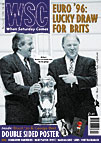 Gary Oliver examines the latest attempt to fiddle about with the structure of the Scottish League – and explains why the issue is unlikely to go away
Gary Oliver examines the latest attempt to fiddle about with the structure of the Scottish League – and explains why the issue is unlikely to go away
St Andrew’s Day, Hogmanay and Burns’ Night – all significant anniversaries in the Scottish calendar. But football fans are accustomed to an alternative winter night ritual: Self-Preservation Day, the annual attempt to force league reconstruction. Eighteen months ago, the clubs formed four divisions of ten and, to secure sponsorship by Bell’s, agreed a five-year respite from further change. A period of stability at last? You must be joking.
The latest wheeze, championed by – and here’s a surprise – clubs struggling to either reach or stay in the Top Ten, is for leagues of 16-12-12. And last month the League Management Committee rejected an attempt to put this proposal to an EGM. However, the matter is unlikely to rest.
The latest blueprint for change was the handiwork of chairmen from Dundee United, St Johnstone, Airdrie and Clydebank. The credentials of these gentlemen – who profess to speak for the larger provincial clubs – make interesting reading.
Jim McLean of Dundee United was one of the Infamous Five who attempted to launch the so-called Super League: an exclusive league, with as few as eight teams, it was proclaimed to be “the way ahead”. But that was before Ivan Golac wiped out twenty years’ work in the space of twenty months: with United relegated and struggling to return, a larger top division is suddenly exigent.
The stench of hypocrisy also hangs heavy elsewhere: Geoff Brown at St Johnstone and George Peat of Airdrie scuttled down the same primrose path and were prepared to withdraw their clubs from the Scottish League with nary a thought for those excluded. Brown and Peat now argue that the Premier Division should be large enough to accommodate ambitious clubs. But a league will remain vibrant only if there are credible contenders outside the top division competing for places.
As a consequence of the competition, the First Division is consistently Scotland’s most exciting and entertaining league. Attendances have risen accordingly: in 1988, Raith Rovers’ average of less than 2500 was the highest in a division then populated by part-time clubs; today, crowds of double and treble that figure are commonplace at various grounds.
A league of sixteen might indeed palliate a few clubs. But proponents should be wary: if the present First Division represents purdah, failure to stay in an expanded top division would be far more catastrophic. And many of the clubs seeking to preserve their full-time status might also note that it was during the death throes of the old 18-team league, in the late 1960s and early 1970s, that they were forced to go part-time.
The agitators deny they are acting from self-interest and argue that increasing to 16 teams will help nurture young talent. But youth opportunity is largely a matter of managerial attitude and courage: Stephen Glass was last season instrumental in Aberdeen avoiding relegation; Hearts’ Gary Locke and Alan Johnston, sidelined by previous managers, have now justified the faith of Jim Jeffries; and at Raith, Jimmy Nicholl’s young bucks have twice claimed the First Division championship, as well as the Coca Cola Cup.
For other bosses, though, a 10-team league is simply a convenient alibi: one could double the size of the league and John Lambie would still send his Falkirk team into the trenches.
Further league reconstruction remains unlikely until a proposal meets with the approval of Rangers, Celtic and whoever else happens to be clinging to their coat-tails. And the Old Firm would seek to restrict membership of the Premier Division to the names on their Christmas card lists, rather than support a structure that might allow East Fife or Stenhousemuir the odd season in the sun.
The arguments will rumble on, irrespective of the five-year moratorium. As Airdrie’s George Peat commented: “If you get on the wrong bus, you don’t wait for the terminus before getting off.” So if you missed the latest attempt to alter the Scottish leagues, don’t worry, there’ll be another along in twenty minutes.
From WSC 108 February 1996. What was happening this month